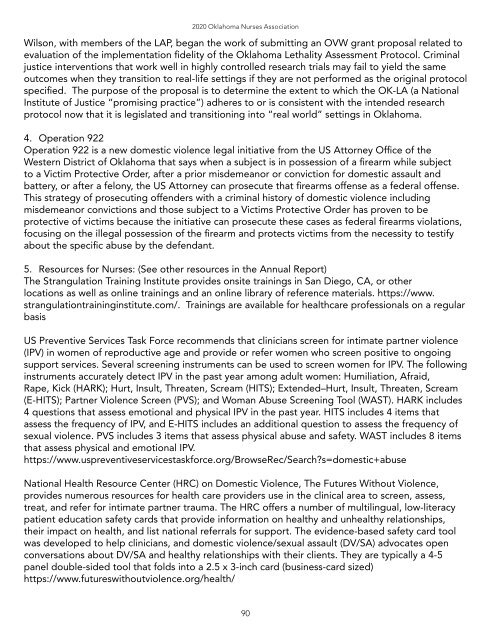Oklahoma 2020 Book of Reports
You also want an ePaper? Increase the reach of your titles
YUMPU automatically turns print PDFs into web optimized ePapers that Google loves.
<strong>2020</strong> <strong>Oklahoma</strong> Nurses Association<br />
Wilson, with members <strong>of</strong> the LAP, began the work <strong>of</strong> submitting an OVW grant proposal related to<br />
evaluation <strong>of</strong> the implementation fidelity <strong>of</strong> the <strong>Oklahoma</strong> Lethality Assessment Protocol. Criminal<br />
justice interventions that work well in highly controlled research trials may fail to yield the same<br />
outcomes when they transition to real-life settings if they are not performed as the original protocol<br />
specified. The purpose <strong>of</strong> the proposal is to determine the extent to which the OK-LA (a National<br />
Institute <strong>of</strong> Justice “promising practice”) adheres to or is consistent with the intended research<br />
protocol now that it is legislated and transitioning into “real world” settings in <strong>Oklahoma</strong>.<br />
4. Operation 922<br />
Operation 922 is a new domestic violence legal initiative from the US Attorney Office <strong>of</strong> the<br />
Western District <strong>of</strong> <strong>Oklahoma</strong> that says when a subject is in possession <strong>of</strong> a firearm while subject<br />
to a Victim Protective Order, after a prior misdemeanor or conviction for domestic assault and<br />
battery, or after a felony, the US Attorney can prosecute that firearms <strong>of</strong>fense as a federal <strong>of</strong>fense.<br />
This strategy <strong>of</strong> prosecuting <strong>of</strong>fenders with a criminal history <strong>of</strong> domestic violence including<br />
misdemeanor convictions and those subject to a Victims Protective Order has proven to be<br />
protective <strong>of</strong> victims because the initiative can prosecute these cases as federal firearms violations,<br />
focusing on the illegal possession <strong>of</strong> the firearm and protects victims from the necessity to testify<br />
about the specific abuse by the defendant.<br />
5. Resources for Nurses: (See other resources in the Annual Report)<br />
The Strangulation Training Institute provides onsite trainings in San Diego, CA, or other<br />
locations as well as online trainings and an online library <strong>of</strong> reference materials. https://www.<br />
strangulationtraininginstitute.com/. Trainings are available for healthcare pr<strong>of</strong>essionals on a regular<br />
basis<br />
US Preventive Services Task Force recommends that clinicians screen for intimate partner violence<br />
(IPV) in women <strong>of</strong> reproductive age and provide or refer women who screen positive to ongoing<br />
support services. Several screening instruments can be used to screen women for IPV. The following<br />
instruments accurately detect IPV in the past year among adult women: Humiliation, Afraid,<br />
Rape, Kick (HARK); Hurt, Insult, Threaten, Scream (HITS); Extended–Hurt, Insult, Threaten, Scream<br />
(E-HITS); Partner Violence Screen (PVS); and Woman Abuse Screening Tool (WAST). HARK includes<br />
4 questions that assess emotional and physical IPV in the past year. HITS includes 4 items that<br />
assess the frequency <strong>of</strong> IPV, and E-HITS includes an additional question to assess the frequency <strong>of</strong><br />
sexual violence. PVS includes 3 items that assess physical abuse and safety. WAST includes 8 items<br />
that assess physical and emotional IPV.<br />
https://www.uspreventiveservicestaskforce.org/BrowseRec/Search?s=domestic+abuse<br />
National Health Resource Center (HRC) on Domestic Violence, The Futures Without Violence,<br />
provides numerous resources for health care providers use in the clinical area to screen, assess,<br />
treat, and refer for intimate partner trauma. The HRC <strong>of</strong>fers a number <strong>of</strong> multilingual, low-literacy<br />
patient education safety cards that provide information on healthy and unhealthy relationships,<br />
their impact on health, and list national referrals for support. The evidence-based safety card tool<br />
was developed to help clinicians, and domestic violence/sexual assault (DV/SA) advocates open<br />
conversations about DV/SA and healthy relationships with their clients. They are typically a 4-5<br />
panel double-sided tool that folds into a 2.5 x 3-inch card (business-card sized)<br />
https://www.futureswithoutviolence.org/health/<br />
90

















